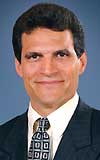
A Global Force for Human Rights
 Linda Simmons Hight |
 Tom Paquette |
||
| The Universal Declaration of Human Rights: A beacon for civilization that must be known and used in all lands. |
 Thomas G. Whittle |
||
America continues to be shocked on a regular basis with similar tales of horror.
And, inevitably, we think back to that clear September morning in 2001 and the loud drone of low-flying airliners—when the world changed forever and the war on terror was launched.
Since that day, in balancing security and liberty, America has sought to protect lives while defending individual rights. The good news is that this is not an unmarked trail.
On December 10, 1948, in the wake of World War II and over the graves of millions of war dead, the Universal Declaration of Human Rights was adopted by nations throughout the world. The most universal human rights document in existence, it is a beacon for civilization based upon respect for individuals, regardless of race, sex, religion or ethnicity.
Following the Declaration came other human rights instruments—the Geneva Conventions—which define and guarantee basic human rights protections to war combatants, civilians and journalists. These tools, combined with simple common sense and judgment, exist to guide leaders and nations in that balance of security and liberty. They tell us that every person shall be considered innocent until proven guilty and that each is protected equally before the law—but also that we deserve protection from the destructive acts of the few.
Ironically, the late 1940s also saw the start of the Cold War, and the beginning of the race to develop weapons not only as overt as nuclear warheads, but as tactics of covert warfare, all in an attempt to gain an upper hand. Included in this arsenal were diabolical mind manipulation and interrogation methods crafted by intelligence-linked psychiatrists. Theirs was an “unconventional” battlefront that utilized tools recast from a conventionally totalitarian die.
These programs took on a life of their own in the 1950s and ’60s—with the focus on mind manipulation through pain, drugs, hypnosis, electroshock and other means of torture that mock the very essence of the Universal Declaration.
Freedom’s editors believe that Earth’s 6.5 billion stand at a crossroads. Thus, we dedicate this issue to human rights awareness, starting at an individual level, with a working comprehension of what human rights are—and an understanding of the consequences of any violation for both perpetrator and victim.
Human rights are defined as “the basic rights and freedoms to which all human beings are entitled, often held to include the right to life and liberty, freedom of thought and expression, and equality before the law.” They are based upon respect for each individual and his or her right to these freedoms.
The Declaration and its articles (abridged and included here) are for your use to help bring about a neighborhood, a community, a nation and a world of which you can be proud.
These are the essence of a global human rights force that not only can but must prevail.
The early 21st century can be known to posterity as the time of the war on terror. Or it can be known as the age when true human rights came to be realized by all mankind.
While we must not lose our grip on security, our eyes must remain on the positive values embodied in the Universal Declaration of Human Rights—and indeed in our own Constitution and Bill of Rights.
– The Editors
|
Your Views
Freedom Magazine welcomes your views on all magazine topics via fax or e-mail. Fax: (323) 960-3508 e-mail: editor@freedommag.org Please include your address and daytime phone number. Published letters may be edited for brevity and clarity. |

